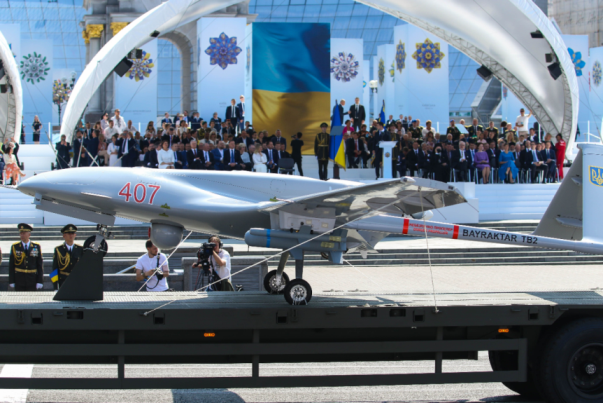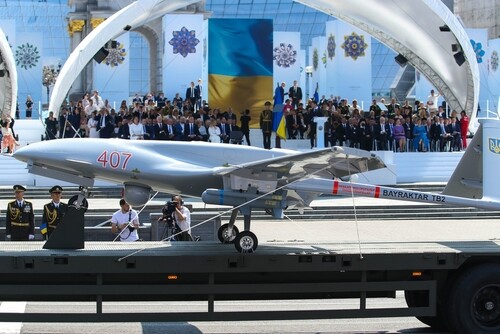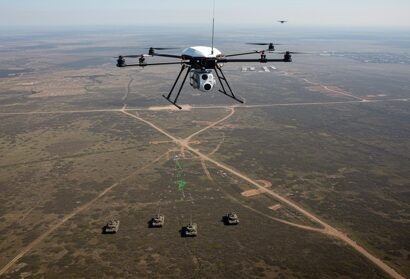Abstract: The creative use of resources can be critical to the outcome of wars, often due to their use by irregular and non-state actors. ISIS’ use of commercial drones during their attack on Mosul questioned the state-based monopoly of unmanned aerial systems. The employment of cheap commercial drones on the battlefield has caused a new kind of psychological, informational, and operational warfare.
Problem statement: How to understand the threat deriving from cheap armed drones and how Ukraine employs them on the contemporary battlefield?
So what?: Military and defence analysts should delve deeper into researching how and when the key innovations and breakthroughs of using cheap commercial drones occurred. They should ask whether the evolution of drone employment in war can be classified as a revolution in military affairs because UAS have changed how wars are fought and have impacted planning factors like time and distance, especially for sustainment, movement, and manoeuvre.

Source: shutterstock.com/Lina Reshetnyk
Small Drones Reshaping The Battlefield
Every war or conflict experiences some battlefield innovation in manoeuvre, sustainment, weapons and staff procedures, even though the principles of war have largely remained the same. A common denominator of all wars is that they drive innovation. Historically, forces operating against a superior enemy avoided decisive battles, relied primarily on exhaustion and attrition strategies, and engaged in innovative ways to fight the enemy. This relates to the famous saying of General Giap, “they have to win; for us, it’s enough not to lose,”[2] when talking about the attrition war in Vietnam.
In 1999, two Air Force Colonels from People’s Liberation Army (PLA), Qiao Liang and Wang Xiangsui, wrote a book called Unrestricted Warfare, which in simple terms, argues that China should wage war using all military and non-military means, especially deception, cyber, espionage, and psychological, and avoid direct military confrontation against the superior American military might as much as possible, always aiming at defeating their adversary in every domain, compete in every domain, including sports and culture. According to an article from Knoll et al. writing for West Point’s Modern War Institute, “irregular warfare is so much integrated with conventional tactics and operations that it is not even identified as irregular.” The People’s Liberation Army (PLA) is focused on winning informational wars, and psychological, legal, and cyber warfare are central to information warfare and victory in a conventional conflict.[3]
Irregular warfare is so much integrated with conventional tactics and operations that it is not even identified as irregular.
Sun Tzu and Clausewitz argue that deception, indirect war, and clear and well-thought objectives are the best way to beat the enemy.[4] As battle develops, the party that allows and aims for innovation and creativity and employs critical resources at the right time and place will likely achieve decisive success. Henceforth, we can see that Unrestricted Warfare and overall Chinese strategy is an application of these principles in a quest for global power status.
ISIS and Commercial Drones
ISIS is a perfect example of the use of unrestricted and irregular warfare and the efficiency and efficacy of the brutal tactics employed by its followers. In 2014, ISIS took control of Mosul, Iraq’s second-largest city. In doing so, it made history by becoming the first-ever terrorist organisation to use armed drones in combat; the drones, armed with explosives, attacked Iraqi and other coalition forces defending the city.[5] The psychological and physical effects resulted in casualties and desertion from the regular Iraqi army.
The divisions in the Iraqi military and lack of unity of effort in the fight against ISIS due to tribalism and sectarian divisions caused an initial failure to act decisively against ISIS. The Iraqi army had to retreat, regroup, and reconsolidate with the help of the American military, who provided mentorship, long-range fires, and combat air support.[6]
In Iraq, commercial drones provided possibilities for unexplored aerial assets and techniques based on the attributes that cheap drones can offer. For illustration, commercial drones weigh up to 20 kg, and a few kilograms carrying capacity costs from $500 to $10,000 based on quality and characteristics. In contrast, UCAVs (Unmanned Combat Aerial Vehicles) weigh over 600 kg, can carry up to 270 kilograms and cost millions of dollars.[7]
In Iraq, commercial drones provided possibilities for unexplored aerial assets and techniques based on the attributes that cheap drones can offer.
ISIS initially adapted cheap commercial drones for military purposes for intelligence, monitoring of terrain, and surveillance, but later adapted them for offensive operations by attaching improvised explosive devices. It is worth noting that until that moment, only large and well-funded armies could afford armed drones for Intelligence, Surveillance, Target Acquisition, and Reconnaissance (ISTAR) due to the high cost of the technology. However, using cheap modified drones for military purposes, ISIS caused a moment of reckoning, and many militaries and non-military, state and non-state violent actors have begun to consider the possibilities opened by this field.
While the world was slowly starting to watch the defeat of ISIS, the war in Ukraine erupted in Donbas.[8] Around the same time in Ukraine, a group of enthusiastic I.T. professionals voluntarily formed a unit called Aerorozvidka; this group initially started buying cheap commercial drones and modifying them for military purposes. After two years, in 2016, Aerorozvidka managed to develop its own UAV, called the R-18, and is currently producing several per day and delivering them to different units of the Ukrainian military.
The R-18’s production costs are around $130,000 per unit, making it cheaper than almost all other imported systems.[9] The utility of this system is seen in the fact that Aerorozvidka is credited for helping to stop the 40-mile-long Russian column on its way to Kyiv and helped defeat a Russian airborne attack at Hostomel airport in the initial days of the war in 2022.[10]
The innovation and creativity of non-state actors like ISIS and Aerorozvidka broke the exclusivity of UAS ownership, which had generally been seen as too expensive for non-state actors. The use of cheap commercial drones by ISIS and Aerorozvidka paved the way for the employment of UAS, as we see it today in Ukraine and elsewhere. While long-range strike UASs remain expensive, cheaper versions with impressive targeting capabilities, have been developed and employed during wars and conflicts in the intervening years.
Bayraktar TB2
While the campaign against ISIS was raging, the Turkish military had already been pushing for higher independence and self-sustainability in defence industries and the sustainment of military technology. Through these efforts, Türkyie had already developed a state-sponsored program for military-purpose drones manufactured by Baykar Defence, whose flagship product: TB2 Bayraktar, made its first flight in 2014. Turkish pride exemplified how a country with a well-developed and ambitious defence industrial capability developed an effective and more affordable UAS.
Bayraktar is an advanced UAS with 24-hour endurance with an estimated price of $5-5.5 million per unit. Compared to an American Reaper drone cost of $16.9 million, it is considerably cheaper, which may be one of the reasons for its proliferation. The use of cheap commercial drones by non-state actors and the introduction of more affordable and lethal TB2 drones by Türkiye have reshaped the battlefield and enabled access to UAS for more countries around the globe.[11]
The use of cheap commercial drones by non-state actors and the introduction of more affordable and lethal TB2 drones by Türkiye have reshaped the battlefield and enabled access to UAS for more countries around the globe.
When the second war for Nagorno-Karabakh broke out in 2020 between Armenia and Azerbaijan, the Turkish military had already developed and tested Türkyie’s drone program during their incursions into Syrian and Iraq against Kurdish guerillas. As a firm ally of Azerbaijan, Türkyie supplied drones and sent operators during the war. Azerbaijan ultimately won and made advances into Armenian territory with the help of Bayraktar drones conducting attacks in the depths of Armenian defensive lines and destroying their air defence systems and command and control centres.[12]
There is no question that NATO countries and those like Russia and China have developed UAS and used them on various occasions. However, they were still a scarce commodity that few could afford. Therefore, seeing Bayraktar drones in a conventional war used by Azerbaijan against a Russian ally, Armenia, showed that UAS can be helpful and, if used wisely on the battlefield, can influence the war’s outcome.
February 2022
Russia failed miserably when it invaded Ukraine in 2022; it seems that one of the causes of Russia’s failures was the Ukrainians’ will to fight. However, early-on UAS’s also played an important role when Russian soldiers seemed unaccustomed to being on the receiving end of drone attacks, which were comparatively cheap and very effective. Furthermore, drone footage served Ukrainian information operations as they recorded the drone attacks and published the videos on social media.
Russian attacks against Ukraine’s capital, Kyiv, with swarms of cheap Iranian Shahed loitering munitions, are an example of how a global power like Russia, due to the extent of war and substantial logistical needs, has been forced to adapt and use cheap drones to achieve its strategy of attrition against Ukrainian civilian targets in an attempt to break their will to fight. Russia is using Iranian drones due to its inability to massively produce them and is lagging behind on the UAS program compared to other countries.[13] Furthermore, during the inspection of an Iranian Shahed drone shot down in Ukraine in April, Chinese-made parts were discovered which had been manufactured in January 2023. This indicates that China indirectly helped Russia wage war in Ukraine by supplying the parts to Iran to keep up the intense and quantitative production of its drone program supplied to Russia.[14] So far, Russia has fired over 700 drones in different attacks against Ukraine. Hence, it seems China has not followed the U.S. requests and pressure to cut off supplies of drone parts to Iran to disable them from producing Shahed loitering munitions.
Iranian loitering munitions are used for attacks against civilian and military targets and represent a Russian line of effort to deplete the Ukrainian air defence assets. So far, Ukraine has done a great job protecting its skies against Russian missile and fighter jet attacks. Hence, sending Shaheds to do whatever damage they can is an attritional tool for Russians, and reports note that still drones and missiles can penetrate Ukrainian air defence systems.[15]
Iranian loitering munitions are used for attacks against civilian and military targets and represent a Russian line of effort to deplete the Ukrainian air defence assets.
Anton Geraschenko, an adviser to Ukraine’s Ministry of Internal Affairs, declared that “this war is a war of drones.” Ukraine has effectively used drones for ISR, direct attacks on Russian positions, and assisting artillery locating Russian batteries and troop movements. Furthermore, besides importing as many drones as possible from supporting countries, Ukraine also developed its software that links the UAS with geolocation capabilities for artillery, intelligence, manoeuvre and command and control purposes. The Ukrainian UAS program has advanced and improved but is still insufficient to sustain its needs.[16] Ukraine managed to conduct a symbolic drone attack in the heart of Moscow on a lower scale and capacity compared to Russian attacks on Kyiv as a retaliation. Both countries use UAS en-masse on the battlefield, and they serve the strategy of attrition, and neither can sustain their needs for UAS on the battlefield and are forced to import them from foreign suppliers.
Even though there are possibilities to protect the assets against swarm attacks, it is impossible to defend everywhere and at once. Hence, drones, at least on the tactical level of the battlefield, can impact tactical gains. The goal of loitering munition attacks in large quantities is to discover air defence systems, expend the adversaries’ air defence missile systems, do whatever damage they can on critical infrastructure, and cause ongoing insecurity toward the enemy, even though the killing power might be marginal. With this vast employment of drone attacks on the battlefield, the protection of troops has also become more critical than ever. Camouflage, protected lines of defence, cover and concealment (basic military skills) are critical details that will save lives.
Finally, creativity in employing different military and non-military resources in war belongs to leaders and soldiers who can think creatively and are willing to go beyond the standard operating procedures and their comfort zones. It is up to leaders to encourage innovation and initiative to prevail against the enemy. UAS are only a fraction of the list that militaries have on their arsenal; however, their criticality shown in recent wars indicates that they can be decisive at the tactical level on the battlefield.
We live in a time when human life is valued more than ever in history; therefore, it is our instinct to risk a drone or any other robotic or unmanned system instead of the lives of our soldiers. Maybe drones are only shaping the way for future human-like robots and Artificial Intelligence to do the job for us.
One Size Does Not Fit All
Cheap commercial drones, employed by non-state actors like ISIS and Aerorozvidka, have revolutionised drone usage and inspired less wealthy state actors that lacked the highly expensive and scarce UAS to develop simpler and more affordable UAS to conduct ISR and targeting against the enemy. Cheap commercial drones are primarily used and modified by non-state actors. In contrast, more affordable UAS systems like TB2 are primarily used by different states due to their impressive capabilities and reliability, which were demonstrated on the battlefields during Turkish incursions in Syria, during the Armenia-Azerbaijan war and currently in Ukraine. During the war in 2020 between Armenia and Azerbaijan, TB2 drones played a key role in the Azerbaijani victory, and the same type of drone was used very effectively by Ukraine against Russian attacking formations and columns. Furthermore, many donations and funding pages from different countries were opened to get funds to buy more drones for Ukraine.[17] However, there are also drawbacks and disadvantages to using UAS in contested air space and battlefields, especially now with the introduction of many anti-drone systems, and this can decrease the effects of UAS on the battlefield. In contrast, non-state actors can still get their hands on commercial drones and modify them for their purposes. However, state actors should take note of the Ukrainian R-18, Iranian Shahed and Turkish TB-2 and their effectiveness on the battlefield and the necessity for their employment.
More affordable UAS systems like TB2 are primarily used by different states due to their impressive capabilities and reliability, which were demonstrated on the battlefields during Turkish incursions in Syria, during the Armenia-Azerbaijan war and currently in Ukraine.
It is not without notice that the use of swarm drone tactics from Russians with cheap Iranian-made Shahed loitering munitions, supplied with spare parts from China, will further deepen the division between East and West and add to the strategic competition in a multipolar world between the U.S., China and Russia and their respective allies. As a result, we will see an expansion of drone usage and further automation of aircraft and other military equipment with the help of artificial intelligence, and the will to fight combined with the ability for sustainment will again prove key to winning wars in the future, as proven in history.
Ali Haxhimustafa is an army officer in the Kosovo Security Forces, he has more than 15 years of army service in different staff and commanding positions. He holds an MBA from Sheffield University in the U.K. and is a recent graduate from the U.S. Army Command and General Staff College, Fort Leavenworth. His research interests include Defence, Security, Defence Industry, and Innovation. Earlier publications include An Approach for a Character Development Strategy for the Center for University Studies, published by War and Peace Journal.[1] The views contained in this article are the author’s alone and do not represent the views of the Kosovo Security Force.
[1] Yangmo Ku, “International Symposium of Military Academies (ISOMA), Special Edition,” Journal of Peace and War Studies, October 2021, https://www.norwich.edu/images/centers/pawc/jpws/jpws-2021-03-bllaca-ramadani-haxhimustafa-shaqiri.pdf.
[2] Cecil Currey Victory at Any Cost: The Genius of Viet Nam’s Gen. Vo Nguyen Giap, Potomac Books, 2005, 54.
[3] David Knoll, Kevin Pollpeter and Sam Plapinger. “China’s Irregular Approach to War: The Myth of a Purely Conventional Future Fight.” Modern War Institute. Last modified, April 27, 2021, https://mwi.usma.edu/chinas-irregular-approach-to-war-the-myth-of-a-purely-conventional-future-fight.
[4] Handel, Michael I. “Corbett, Clausewitz, and Sun Tzu.” Naval War College Review (2000): 106-124.
[5] T. S. Allen, Kyle Brown and Jonathan Ascoma’s, “How the Army Out-Innovated the Islamic State’s Drones,” War on The Rocks (December 2020), https://warontherocks.com/2020/12/how-the-army-out-innovated-the-islamic-states-drones/#:~:text=The%20group%20determined%20that%20most,rely%20on%20civilian%20navigation%20systems.
[6] Marina Ottaway, “The War on ISIS: U.S Success without payout,” Wilson Center 116 (October 2017), https://www.wilsoncenter.org/sites/default/files/media/documents/publication/116_war_on_isis_-_ottaway.pdf.
[7] “How are Military Drones Different from Commercial Drones?,” Zena Drones, last accessed May 01, 2016, https://www.zenadrone.com/how-are-military-drones-different-from-commercial-drones/.
[8] Mathew Dresch, “Inside Ukrainian Drone Factory that crushed 40-mile Russian death convoy,” Mirror, last modified May 04, 2022, https://www.mirror.co.uk/news/world-news/inside-ukrainian-drone-factory-crushed-26860187
[9] Idem.
[10] Julian Borger, “The drone operators who halted Russian convoy headed for Kyiv,” The Guardian, last modified March 28, 2022, https://www.theguardian.com/world/2022/mar/28/the-drone-operators-who-halted-the-russian-armoured-vehicles-heading-for-kyiv
[11] Aaron Stein, “The TB2: The value of a cheap and “good enough” drone,” Atlantic Council, last modified August 20, 2022, https://www.atlanticcouncil.org/content-series/airpower-after-ukraine/the-tb2-the-value-of-a-cheap-and-good-enough-drone/.
[12] hattacharya, Subhendu, and Diana Fernando, “Technology Played Decisive Role in Armenia-Azerbaijan Conflict of 2020,” International Journal of Research in Engineering, Science and Management 4, no. 9 (2021): 40-42.
[13] Ellie Cook, “Russia Has a Big Drone Problem,” Newsweek, last modified June 01, 2023, https://www.newsweek.com/russia-drone-production-ukraine-iranian-shahed-uavs-1803816.
[14] “Chinese Parts Found in Iranian Drones Used by Russia in Ukraine: Report. Statecraft,” last modified June 13, 2023, https://www.statecraft.co.in/article/chinese-parts-found-in-iranian-drones-used-by-russia-in-ukraine-report.
[15] Vasco Cotovio, Frederik Pleitgen, William Bonnet and Svitlana Vlasova, “Ukraine’s Air Defenses are better than ever, but Dnipro devastation shows they’re not perfect,” CNN, last modified on May 27, 2023, https://edition.cnn.com/2023/05/27/europe/ukraine-air-defense-gepard-intl/index.html.
[16] Vasco Cotovio, Tim Lister, Frederik Pleitgen, William Bonnet and Daria Tarasova, “Exclusive: Inside Ukraine’s Secretive Drone Program,” CNN, last modified June 03, 2023, https://www.cnn.com/2023/06/03/europe/ukraine-secretive-drone-program-russia-war-intl/index.html.
[17] “Lithuania donates crowdfunded drone to Ukraine,” BBC, last modified, July 07, 2022, https://www.bbc.com/news/av/world-europe-62074011.






